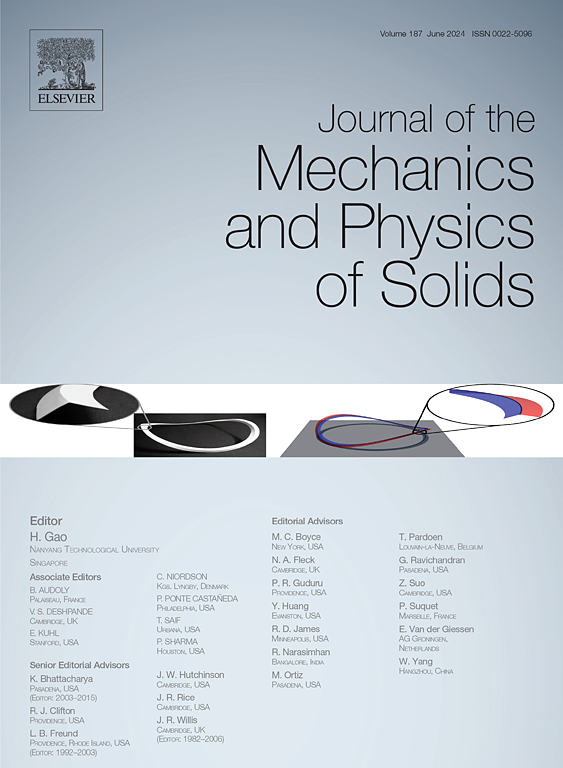多层二维结构层间滑移介导的大挠度弯曲:理论与应用
IF 6
2区 工程技术
Q2 MATERIALS SCIENCE, MULTIDISCIPLINARY
引用次数: 0
摘要
多层二维(2D)材料通常在膜和大挠曲板之间表现出弯曲轮廓和非线性响应,主要是由于显著的层间滑移。然而,目前还缺乏一个全面的理论模型来量化这一现象。本文采用基于复变形式的能量变分方法,建立了多层二维结构大挠度弯曲的一套简洁、通用的控制方程。导出了一维和轴对称加压气泡的精确解和微扰解,并通过有限元模拟验证了其正确性。分析结果定量地揭示了剪切因子(一个量化层间滑移阻力的无量纲参数)对系统弯曲轮廓和响应的影响,以及从膜状向板状行为的转变。该框架不仅解释了以往在多层二维材料实验中测量的非线性弯曲行为,而且可以直接提取层间剪切参数。因此,它为应变工程、界面特性表征和基于多层二维系统的功能器件设计提供了重要的见解。本文章由计算机程序翻译,如有差异,请以英文原文为准。
Interlayer-slip-mediated large deflection bending of multilayer two-dimensional structures: theory and application
Multilayer two-dimensional (2D) materials often exhibit bending profiles and nonlinear responses that lie between membranes and large deflection plates, primarily due to significant interlayer slip. However, a comprehensive theoretical model to quantify this phenomenon remains lacking. By employing an energy variational approach based on complex-variable formalism, this work establishes a concise and general set of governing equations for large deflection bending of multilayer 2D structures. Exact and perturbative solutions for one-dimensional (1D) and axisymmetric pressurized bubbles are derived and validated by Finite Element Method (FEM) simulations. The analytical results quantitatively reveal the influence of the shear factor, a dimensionless parameter quantifying interlayer slip resistance, on the system’s bending profiles and responses, as well as the transition from membrane-like to plate-like behavior. This framework not only explains the nonlinear bending behavior measured in previous experiments on multilayer 2D materials, but also enables direct extraction of interlayer shear parameters. Consequently, it offers critical insights for strain engineering, interfacial property characterization, and the design of functional devices based on multilayer 2D systems.
求助全文
通过发布文献求助,成功后即可免费获取论文全文。
去求助
来源期刊
CiteScore
9.80
自引率
9.40%
发文量
276
审稿时长
52 days
期刊介绍:
The aim of Journal of The Mechanics and Physics of Solids is to publish research of the highest quality and of lasting significance on the mechanics of solids. The scope is broad, from fundamental concepts in mechanics to the analysis of novel phenomena and applications. Solids are interpreted broadly to include both hard and soft materials as well as natural and synthetic structures. The approach can be theoretical, experimental or computational.This research activity sits within engineering science and the allied areas of applied mathematics, materials science, bio-mechanics, applied physics, and geophysics.
The Journal was founded in 1952 by Rodney Hill, who was its Editor-in-Chief until 1968. The topics of interest to the Journal evolve with developments in the subject but its basic ethos remains the same: to publish research of the highest quality relating to the mechanics of solids. Thus, emphasis is placed on the development of fundamental concepts of mechanics and novel applications of these concepts based on theoretical, experimental or computational approaches, drawing upon the various branches of engineering science and the allied areas within applied mathematics, materials science, structural engineering, applied physics, and geophysics.
The main purpose of the Journal is to foster scientific understanding of the processes of deformation and mechanical failure of all solid materials, both technological and natural, and the connections between these processes and their underlying physical mechanisms. In this sense, the content of the Journal should reflect the current state of the discipline in analysis, experimental observation, and numerical simulation. In the interest of achieving this goal, authors are encouraged to consider the significance of their contributions for the field of mechanics and the implications of their results, in addition to describing the details of their work.

 求助内容:
求助内容: 应助结果提醒方式:
应助结果提醒方式:


